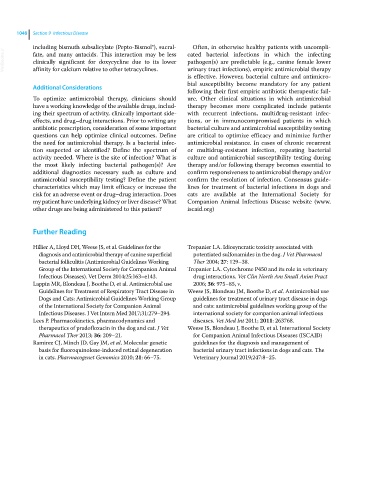Page 1110 - Clinical Small Animal Internal Medicine
P. 1110
1048 Section 9 Infectious Disease
including bismuth subsalicylate (Pepto‐Bismol®), sucral- Often, in otherwise healthy patients with uncompli-
VetBooks.ir fate, and many antacids. This interaction may be less cated bacterial infections in which the infecting
pathogen(s) are predictable (e.g., canine female lower
clinically significant for doxycycline due to its lower
urinary tract infections), empiric antimicrobial therapy
affinity for calcium relative to other tetracyclines.
is effective. However, bacterial culture and antimicro-
bial susceptibility become mandatory for any patient
Additional Considerations
following their first empiric antibiotic therapeutic fail-
To optimize antimicrobial therapy, clinicians should ure. Other clinical situations in which antimicrobial
have a working knowledge of the available drugs, includ- therapy becomes more complicated include patients
ing their spectrum of activity, clinically important side‐ with recurrent infections, multidrug‐resistant infec-
effects, and drug–drug interactions. Prior to writing any tions, or in immunocompromised patients in which
antibiotic prescription, consideration of some important bacterial culture and antimicrobial susceptibility testing
questions can help optimize clinical outcomes. Define are critical to optimize efficacy and minimize further
the need for antimicrobial therapy. Is a bacterial infec- antimicrobial resistance. In cases of chronic recurrent
tion suspected or identified? Define the spectrum of or multidrug‐resistant infection, repeating bacterial
activity needed. Where is the site of infection? What is culture and antimicrobial susceptibility testing during
the most likely infecting bacterial pathogen(s)? Are therapy and/or following therapy becomes essential to
additional diagnostics necessary such as culture and confirm responsiveness to antimicrobial therapy and/or
antimicrobial susceptibility testing? Define the patient confirm the resolution of infection. Consensus guide-
characteristics which may limit efficacy or increase the lines for treatment of bacterial infections in dogs and
risk for an adverse event or drug–drug interaction. Does cats are available at the International Society for
my patient have underlying kidney or liver disease? What Companion Animal Infectious Disease website (www.
other drugs are being administered to this patient? iscaid.org)
Further Reading
Hillier A, Lloyd DH, Weese JS, et al. Guidelines for the Trepanier LA. Idiosyncratic toxicity associated with
diagnosis and antimicrobial therapy of canine superficial potentiated sulfonamides in the dog. J Vet Pharmacol
bacterial folliculitis (Antimicrobial Guidelines Working Ther 2004; 27: 129–38.
Group of the International Society for Companion Animal Trepanier LA. Cytochrome P450 and its role in veterinary
Infectious Diseases). Vet Derm 2014;25:163–e143. drug interactions. Vet Clin North Am Small Anim Pract
Lappin MR, Blondeau J, Boothe D, et al. Antimicrobial use 2006; 36: 975–85, v.
Guidelines for Treatment of Respiratory Tract Disease in Weese JS, Blondeau JM, Boothe D, et al. Antimicrobial use
Dogs and Cats: Antimicrobial Guidelines Working Group guidelines for treatment of urinary tract disease in dogs
of the International Society for Companion Animal and cats: antimicrobial guidelines working group of the
Infectious Diseases. J Vet Intern Med 2017;31:279–294. international society for companion animal infectious
Lees P. Pharmacokinetics, pharmacodynamics and diseases. Vet Med Int 2011; 2011: 263768.
therapeutics of pradofloxacin in the dog and cat. J Vet Weese JS, Blondeau J, Boothe D, et al. International Society
Pharmacol Ther 2013; 36: 209–21. for Companion Animal Infectious Diseases (ISCAID)
Ramirez CJ, Minch JD, Gay JM, et al. Molecular genetic guidelines for the diagnosis and management of
basis for fluoroquinolone‐induced retinal degeneration bacterial urinary tract infections in dogs and cats. The
in cats. Pharmacogenet Genomics 2010; 21: 66–75. Veterinary Journal 2019;247:8–25.

